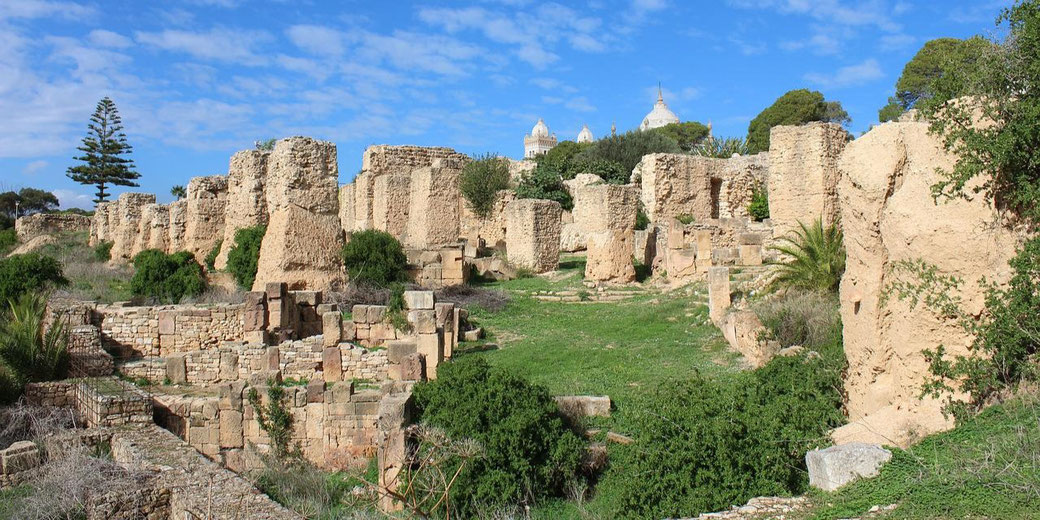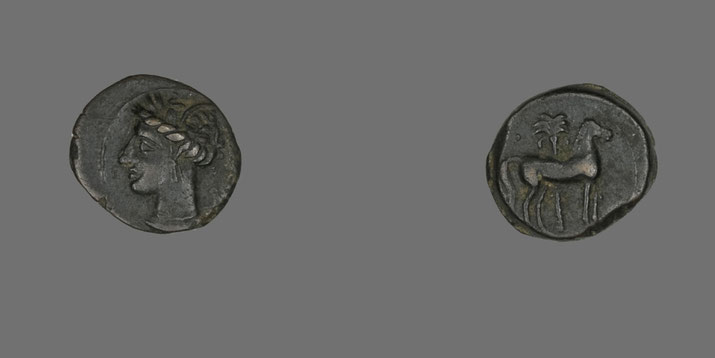The rise of Carthage: Rome's greatest enemy

Carthage was one of the most powerful empires in the ancient world. Its origins can be traced back to a small Phoenician city-state that rose to prominence in the 8th century BC.
Over the years, Carthage grew into a massive empire that controlled vast territories in North Africa and Iberia.
Unfortunately, most of what we know about Carthage only survive in Greek and Roman accounts, who were often the enemies of this culture.
These sources describe the Carthaginians as cruel and wealth-obsessed people who practised horrific human sacrifices as part of their religion.
Historians are aware that the Greeks and Romans are providing an extremely biased historical record, so we need to be cautious when relying too heavily on these sources.
Often, archaeology is the only other evidence we can use to understand what Carthage was like.
The mythical origin story of Carthage's foundation
According to legend, Carthage was founded by a woman named Dido around 814 BC.
She was the daughter of a wealthy Phoenician king and fled her homeland after her brother murdered her husband.
Dido eventually made her way to North Africa where she founded the city of Carthage.
The city was first known as Kar-hadasht (new city), to distinguish it from the ancient Phoenician settlement of Utica nearby.
The Greeks dubbed the city Karchedon, while the Romans called it Carthago, and its ruins are located in the modern city of Tunis.

The archaeological evidence of Carthage's beginnings
Archaeological evidence provides a different story to that presented in the myth of Dido.
The city of Carthage appears to have been settled as a trading port by the Phoenician people around 750 BC.
The Romans would call these people the Punici, which is the Latin word for the Phoenicians, and from where modern historians derive the word 'Punic' from to describe the Carthaginians.
The Phoenician traders probably came from the city of Tyre, an island which is located off the western coast of the Levant.
The Tyrians were famous for their shipbuilding, navigation and trading skills.
Despite beginning as a minor port where Phoenician merchants would stop to resupply or repair their ships, Carthage would quickly grow to be an important economic hub in the wider Mediterranean world thanks to its strategic location and thriving trade routes.
In the seventh century BC, Carthage began to expand its territory by conquest.
It had become a significant commercial center by the 4th century BC.
By the beginning of the 3rd century BC, it had gained control over much of the North African coast, southern Spain (known as Iberia), and the Mediterranean islands of Sardinia, Corsica, western Sicily and the Balearic Islands.
How did Carthage become so wealthy?
The Carthaginian economy was based largely on trade. The city controlled a vast maritime empire that stretched from Spain to Morocco.
Carthage had a huge agricultural sector that produced olive oil, wheat, barley, and livestock, which it exported across its empire, generating a huge amount of wealth.
Their wealth was generated by the taxes and levies placed on trade. As goods came into and out of their ports, the Carthaginians would charge a small fee.
As trade increased, the amount of money they earned also increased. To further profit from this trade, Carthage minted its own coins of silver and gold in the late 5th or early 4th century BC.
Such coinage often depicted images of deities such as Tanit and symbols like the horse.

In addition, the city became famous for its production of purple dye, which was made from the murex shellfish.
This valuable commodity was used to color royal robes and other fine garments.
It was in such demand that Carthage could charge a premium price for any royal family who wanted access to this dye.
The spectacular wealth generated by the city of Carthage quickly attracted merchants and ambitious people from all across the ancient world and, by the 3rd century BC, there were an estimated 200,000 people living in the city.
Carthaginian religion and human sacrifice
The Carthaginians were polytheistic and worshipped a pantheon of gods and goddesses.
The most important deities in the Carthaginian religion were Baal, Tanit, and Melqart.
Baal was the god of weather and fertility. Tanit was the patron goddess of Carthage who protected the city from harm. Melqart was the god of fire, crafts, and healing.
The Carthaginians believed that their gods intervened in human affairs and could be appeased through sacrifices.
They would often offer up animals or even human beings to placate their anger or gain favor.
Human sacrifice was especially common during times of crisis, such as wars or famines.
Roman sources claimed that children were regularly sacrificed to the god Baal Hammon.
For many years, historians thought that these sacrifices were simply anti-Carthaginian propaganda from the Greek and Roman sources.
However, recent archaeological finds appear to support this claim. A cemetery near the ancient city, known as the Tophet of Carthage, was found containing the burnt remains of children, with dedicatory inscriptions explicitly stating that these children were 'offered' to certain gods.

What armies did Carthage have?
The Carthaginian military was one of the most powerful in the ancient world. It was made up of a well-trained mercenary army that was able to field large numbers of troops.
Mercenaries were different to professional armies because they were paid to fight.
This meant that they were not loyal to any one country and would often change sides if the pay was good enough.
The Carthaginian military also made use of elephants in battle. These massive animals were used to charge enemy lines and cause chaos amongst the ranks.
However, Carthage's primary military strength lay in its ships. Their formidable navy was used to protect their trade routes and expand their empire.
To facilitate the building and repair of hundreds of ships, the city of Carthage had a harbour that was second to none.
This harbour was known as the Cothon and was located in the center of the city. It could accommodate up to 220 ships in docks at a time and was surrounded by a massive wall that protected it from enemy attacks.
The city of Carthage itself was located in an ideally defensible position. It was located on a coastal promontory with lakes on either side, which meant that attacking armies could only assault the city from one direction.
This direction was defended by a series of thick, high walls up to 32 kilometres long, 12 metres high and 9 metres thick.
The political structure of ancient Carthage
The government of Carthage was based on an assembly of elected representatives who were answerable to the people.
Unlike its Phoenician parent city, Tyre in Phoenicia, Carthage did not have a monarchy, although it was ruled by a powerful aristocracy made up of competing clans that held all key political, judicial, and military posts.
The most important office in the Carthaginian government was shared by two suffetes, who were elected annually. Initially, the suffetes were in charge of legal matters, but they also incorporated military command over time.
From the 5th century BC, one of the elected suffetes led the Carthaginian military and the other ran the government.
In order for someone to be elected as a suffete, it appears that they needed to have sufficient wealth and a noble family lineage to be eligible.
As a result, a small number of very influential families appear to have dominated these roles.
The Carthaginians also had a Council of Elders (or Senate), which comprised 104 members made up of prominent persons.
These people were known as the 'great ones' and served for life.
It's unclear how these senatorial members were chosen, but it's probable that they numbered between two and three hundred people at different times in Carthage's history.
Evidence suggests that the senate had the power to vote on declarations of war, whether or not to send additional troops to support generals in battle, penalties for commanders who failed in their goals, and whether to accept enemy terms of peace.
Only males from the city of Carthage could become citizens. Women, slaves, and aliens were not eligible.
However, there are indications in the historical record that a second class of citizens might have existed made up of former slaves and foreign artisans.
Carthage and the Punic Wars
The Punic Wars were a series of three wars fought between Rome and Carthage during the 3rd and 2nd centuries BC.
War between these two powers may have been inevitable, as both sought to become the main power in the Italian and Sicilian region.
The first war began in 264 BC when Rome attempted to invade Carthaginian territory in Sicily. The First Punic War ended in 241 BC with a Roman victory.
The terms of the peace treaty were very unfavorable to Carthage and the city had to pay a large indemnity payment to Rome.
The second war broke out in 218 BC when the Carthaginian general Hannibal famously crossed the Alps with his army and invaded Italy.
Despite some stunning victories against the Romans, Hannibal was eventually forced to return to Africa due to a lack of reinforcements.
This led to the Carthaginian defeat in the Battle of Zama in 202 BC and a further series of harsh surrender terms were forced upon Carthage.
The Third Punic War began in 149 BC when Rome accused Carthage of violating the terms of the peace treaty from the previous war.
The conflict ended with the complete destruction of Carthage by the Roman army in 146 BC.
The city was razed to the ground and its inhabitants were sold into slavery.
What happened to Carthage after the Punic Wars?
The Carthaginian Empire was completely destroyed as a result of the Punic Wars.
However, Carthage had been such an important trading partner for Rome that the Romans decided to rebuild the city as a Roman colony over 100 years after its destruction.
However, it would never again be the threat that it had once been, and Rome made sure that the new colony was carefully controlled.
What do you need help with?
Download ready-to-use digital learning resources
Copyright © History Skills 2014-2025.
Contact via email
With the exception of links to external sites, some historical sources and extracts from specific publications, all content on this website is copyrighted by History Skills. This content may not be copied, republished or redistributed without written permission from the website creator. Please use the Contact page to obtain relevant permission.





